Overview of the forestry sector in Türkiye
Türkiye contains a great variety of natural habitats, ranging from Mediterranean, Aegean, and Black Sea beaches to towering coastal and interior mountains, from deeply incised valleys to expansive steppes, from fertile alluvial plains to arid, rocky hillslopes. A myriad of community types and habitat mosaics occurs, containing a rich mixture of plant and animal species, many of which are endemic (Table 1). Complex interactions among species and with their abiotic environment exist and the dynamics of habitat change over an exceedingly long period of human cultural history in the region have added an ever-changing dimension to ecosystem and landscape character.
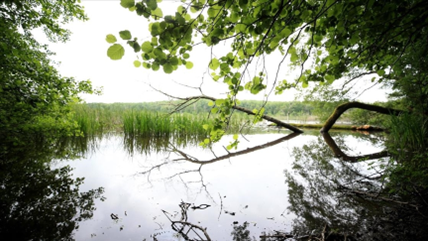
The total forest area of Türkiye in 2020 was 22,933,000 ha. This forest area represents 29,4 % of the total area of the country which means approximately one-quarter of Türkiye’s land are covered by forests and 99% of them are managed and owned by the state. Despite covering only 0.5% of the Earth's surface, Türkiye has a very high species diversity especially in the forest lands.
As of 2020, the tree cover of Turkish forests is 1,697,055 thousand m3. Of these, 95.9% are normal-closed forest areas and 4.1% are closed forest areas with gaps. Between 1973 and 2020, the tree cover of the country’s forests increased by 761,543 thousand m3.
While the forest area in Türkiye accounted for 26.7% of the country’s surface area in 1999, this percentage increased to 29% in 2020.
Türkiye’s environment is characterized by forest and grassland ecosystems, many of which are shared with other neighboring countries along the Mediterranean Sea, the Black Sea, and in the Baltic region. The country has wide range biomes which include the temperate broadleaf and mixed forests, temperate grasslands, savannas, and shrublands, and the Mediterranean forests, woodlands, and scrub. Within these biomes, rich and diverse ecoregions arise to give Türkiye its vegetative characteristics and the diverse fauna. Northern Anatolia has the temperate coniferous forests.

Balkan Mixed Forests
The Balkan mixed forests ecoregion experiences a humid subtropical and humid warm summer continental climate (Koppen classification). Some areas have relatively high rainfall and are said to have a temperate rainforest relict. The mixed forests of Balkans have deciduous oaks dominating most of the areas. In the upper reliefs, European beech and conifers, such Scots pines and Silver firs, grow. Alpine tundra vegetation also grows in the highest peaks.
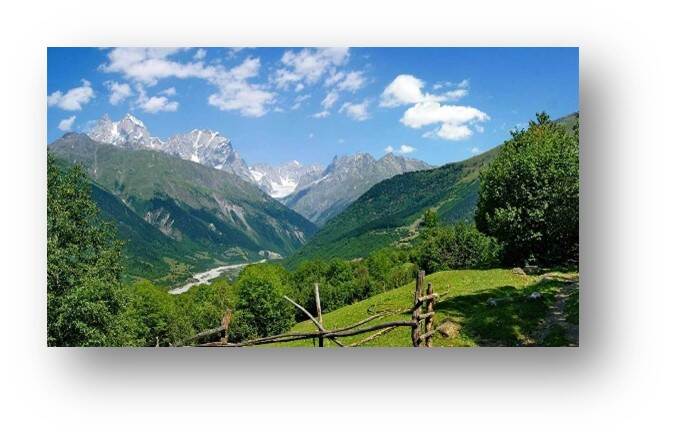
Caucasus Mixed Forests
The Caucasus mixed forests contain a mixture of plant and animal species that roam much of Europe. The Caucasian, black grouse has its home predominantly in the region. Predators such as wolves bear, Asian leopard also live here. The mountain ranges falling to the Black Sea provides a habitat for the
massive range of flora and fauna. The forests contain more than 1500 endemic plant species and two wetlands in Colchida which are necessary for waterfowls and wetland species. These ecosystems are usually protected from human encroachment to save the endangered biodiversity. The Caucasian tur is a large thick goat featured in these forests. Human activities and forests mismanagement pose a threat to the sustainability of the ecosystem. Tree felling and planting of alien species disrupt the ecosystem. However, there are measures underway to regulate, control and protect these threatened biomes and ecosystems.
The region provides a home to such migratory birds as avocets and cranes. The lakes and ponds form habitats and breeding grounds for waterfowl such as the White pelican. The region is characterized by high plateaus and mountains and the rugged landscape is dotted with brilliant Türkiye oak trees during fall giving the land a characteristic yellow look. The ecoregion provide a home for such animals as the marbled polecat, the mountain meadows, and the Turkish chamois. The region experiences a Koppen climate.
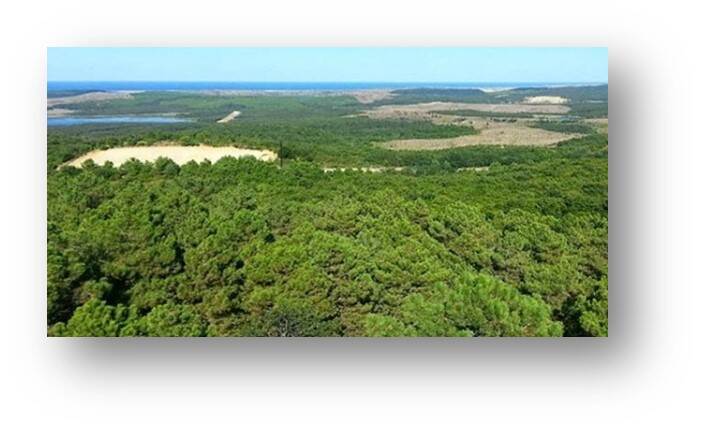
Northern Anatolia Conifer And Deciduous Forests
These ecosystems occupy the northwestern regions of Türkiye, and have warm summers and cool winters with adequate rainfall. Coniferous forests and evergreen conifers predominate most of the areas but in particular areas, there is a mixture of the conifers and the broadleaf deciduous trees. The moist conditions of the forests support an undergrowth of mosses, shrubs, and ferns. These forests sustain high levels of biodiversity. The primary trees are coast redwood, Douglas fir, Sitka spruce, and Kauri. The Northern Anatolian conifer and deciduous forests is an important bird area as it provides critical habitats for the Dalmatian pelican, black stork, and purple heron.
State of management
42% of forests in Türkiye are degraded closed forest areas, and they are inefficient. It is important to rehabilitate inefficient forest areas and convert them into productive areas. More rehabilitation studies were conducted especially between 2006 and 2012. In 2020, forest rehabilitation activities were carried out on a total of 131,062 ha, including afforestation on 28,632 ha area, rehabilitation on 56,576 ha area, erosion control on 20,902 ha, pasture improvement on 10,438 ha area, private afforestation on 4,374 ha area and artificial tensile work on 10,140 ha area.
DISTRIBUTION OF THE FOREST LAND BY FOREST FORM
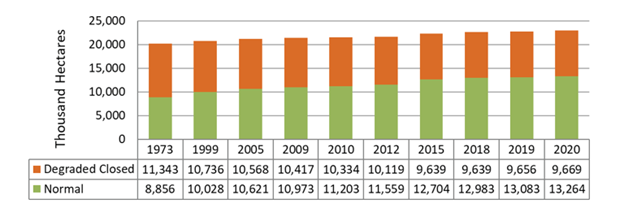
DISTRIBUTION OF FOREST WEALTH BY FOREST FORM
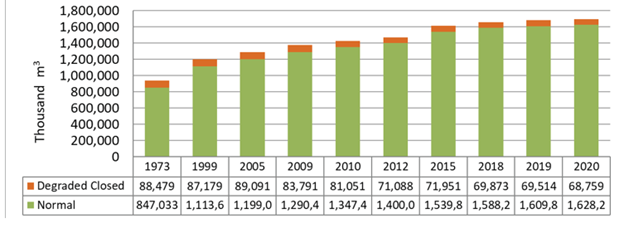
FOREST ESTABLISHMENT ACTIVITIES (ha) (1990-2020)
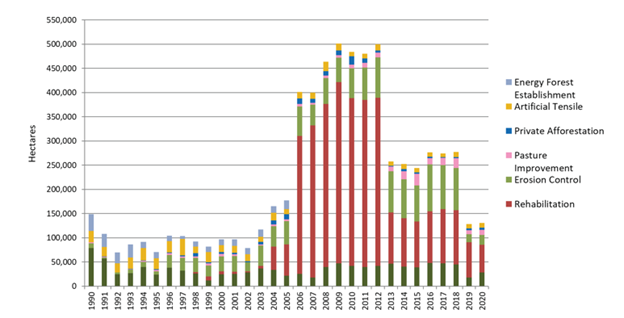
The General Directorate of Forestry (GDF)
The General Directorate of Forestry (GDF) is part of the Ministry of Agriculture and Forestry (MAF) and the main institution in the sector, responsible for the integration policy and supervision of the protection and sustainable forestry management of forest resources in Türkiye. Decision making and forest operations have been planned, organized, guided, managed, and controlled through the Chief Office of the Forest District (COFD), the Directorate of the Forest District (DFD), the Regional Directorate of Forestry (RDF), and also GDF, as respectively and hierarchically . Most of the wood raw material demand is met by GDF. Within the admission of GDF, there are 28 Regional Directorates of Forestry and 12 Forestry Research Institutes.
Definition and use
The definition of forest in Türkiye excludes areas of forest less than 3 ha and areas with species not found in natural forests. Forest areas with a canopy cover of 10 percent or more are classed as “productive forests” and are required to have an allowable cut identified in the forest management plan. As of 2019, 94.72% of the forests are high forest while the rest is coppice forests in Türkiye. During the last fifteen years, the share of high forest area increased due to the decrease in the coppice forests, degraded forest areas, and establishment of new forests. According to the statistics stated by the General Directorate of Forestry (GDF), the growing stock has increased in the last 10 years. In addition, according to the statistics of 2019, 95.9% of the growing stock was specific to productive forests, while 4.1% was that of degraded forests. The total growing stock was estimated at 1.66 billion m3 in 2019. Approximately 50% of the forests are classified as having an economic function, mainly that related to the production of round wood, fire-wood, and non-wood forest products, 42% an ecological function with the purpose of watershed and erosion control and the remaining 8% have functions related to social and cultural aspects .
Economic value
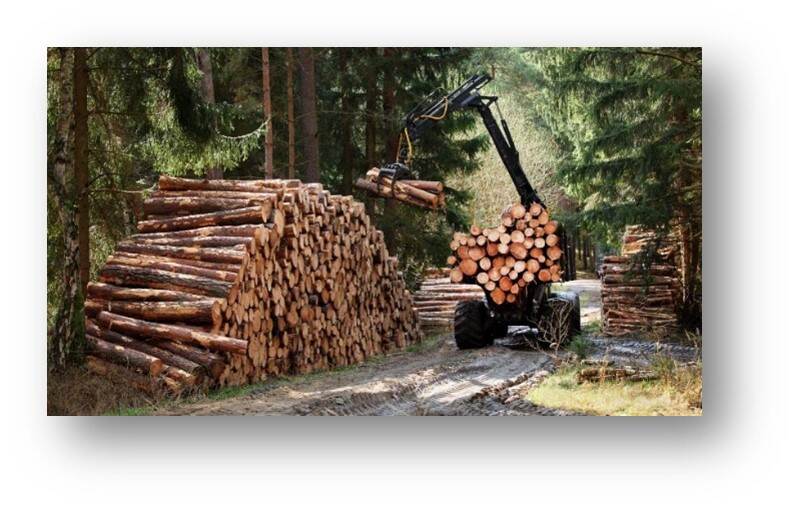
According to the Türkiye Export Council's 2023 Export Strategy Report, exports of forest products in 2023 is predicted to be 16 billion US dollars with an annual average growth rate of 13.7% . The forestry sector, which has an economic size of 12 billion dollars and exports of 2.4 billion dollars in 2013, targets an economic size of 25 billion dollars and an export figure of 8 billion dollars in 2023. In Türkiye, the economic contribution of the forest sector is about 0.8% according to the calculations of Türkiye Statistical Institute which was made based on the monetary value of primary and secondary forest products and services. Considering the subsidies arising from inputs given free of charge or with low cost to other sectors, this ratio reaches up to 2%.
Regarding the distribution of wood raw material usage in Türkiye, the board sector is at the top with 55%, while the timber industry comes next with 25%, being followed by pallet-packaging with 15%, plywood-coating with 2%, paper with 2%, and pole sector with 1%.
Challenges: Economic Diversification and sustainability, urbanisation
Despite the economic potential and biological diversity and environmental value, the forests and the surroundings are prone to external risks and societal pressures.
- According to regulations, all of the forest operations must be accomplished by villagers who live in the forest villages nearest to the workplace. Forest work is the main income for those villagers also called as “forest villagers”. The villages are facing demographic changes and younger people are leaving the rural areas. Also, costly investments into new equipment are difficult for the villagers.
- Climate change and natural disasters: changes in weather patterns and climate change result in the occurrence of extreme weather events (flooding, drought) and environmental risks (fires). This impacts the quality of forests.
- Due to the rapid population increase many natural habitats have been fragmented, reduced in size, degraded or destroyed. Intensive forestry practices have further accelerated the loss of natural forest lands, especially along the coastal Black Sea and coastal Mediterranean and Aegean regions. Natural habitats have also been degraded due to urbanization and construction activities in attractive regions of the country.
- Some economically important plant species in forest ecosystems have been harvested, irrespective of sustainable management principles. Over-exploitation has led either to decline or loss of populations and genetic diversity of many organisms of forest ecosystems. Today, 49% of Turkish forests are considered to be heavily degraded, requiring restoration programs .
